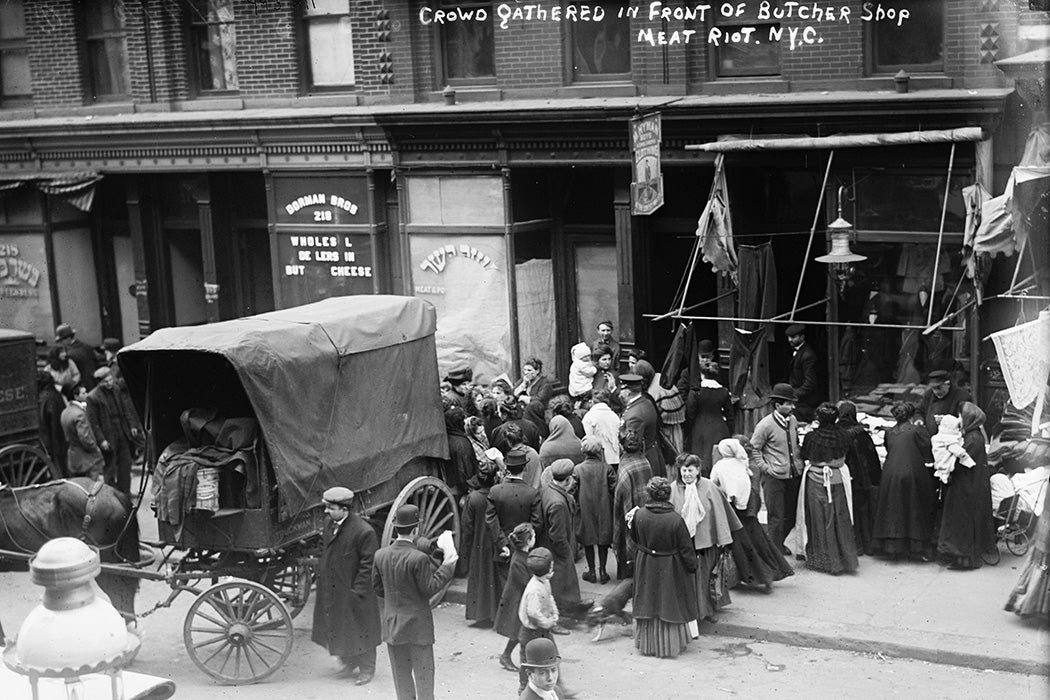May 1902, New York City: the price of kosher meat rises from twelve to eighteen cents a pound, rattling the city’s Jewish immigrant community.
Many Jewish women in turn-of-the-century New York kept kosher kitchens, following the dietary regulations of kashrut, a set of rules for food consumption, preparation, and storage. Derived from scriptures in the Torah, kashrut also governed the slaughtering process. Any butcher advertising meat as kosher agreed to operate according to the dietary laws. Anyone needing kosher meat couldn’t just go to a less expensive shop if that butcher didn’t follow the rules of slaughter.
Not surprisingly, then, the rapid and steep increase in the cost of kosher meat—the result of retailers passing on the rising prices of wholesalers to customers—led to drastic, quick action. According to the late social historian Paula E. Hyman, Lower East Side housewives began agitating for a strike against the butchers. On the evening of May 14, the women gathered to plan their action. The next day, “thousands of women streamed through the streets of the Lower East Side,” Hyman writes, “breaking into butcher shops, flinging meat into the streets, and declaring a boycott.”
Hyman notes that the newspapers of the time considered the rioting both violent and comical.
“Women were pushed and hustled about [by the police], thrown to the pavement . . . and trampled upon,” wrote the Herald. One policeman, trying to rescue those buying meat, had “an unpleasant moist piece of liver slapped in his face.”
Some 20,000 people were reported to have massed in front of New Irving Hall, resulting in the arrest of seventy women and fifteen men for disorderly conduct.
After a day of protest, neighborhood women formed a committee to better organize and strategize. They went from house to house to encourage residents to support the boycott. On May 16, pickets (i.e., human volunteers) stood in front of each kosher butcher shop to talk customers out of their plans to purchase meat. On May 17, efforts expanded even further when the women interrupted synagogue services to spread their message to the community.
“Using the traditional communal tactic of interrupting the Torah reading when a matter of justice was at stake, they called on the men in each congregation to encourage their wives not to buy meat and sought rabbinic endorsement of their efforts,” Hyman writes.
By May 18, most Lower East Side kosher butchers had closed their doors, and the action had spread to Brooklyn, where “four hundred women signed up to patrol neighborhood butcher stores. Buyers of meat continued to be assaulted and butcher shop windows smashed.”
“Support for the boycott was widespread within the community,” Hyman explains. “Friendly crowds packed the courtroom to cheer the arrested women.”
Yet some “Jewish communal leaders were clearly upset by the initiative assumed by the women activists.” For instance, though a rallying figure early on, labor leader Joseph Barondess supposedly urged “the women to be quiet and leave the fighting to the men” at a May 21 conference that had been organized by male communal leaders. And the Allied Conference for Cheap Kosher Meat, which grew out of the conference, appointed only three women to its ten-member steering committee.
By June 5, the boycott was over. The wholesale price of kosher meat dropped to nine cents a pound, meaning that the retail price was a more affordable fourteen cents a pound. And though Hyman notes that the prices began to rise again after the boycott, the movement could still be considered “a qualified success,” thanks to the efforts of the women of the Lower East Side and Brooklyn.
Weekly Newsletter
“As consumers and housewives, they saw their task as complementary to that of their wage-earning spouses,” Hyman writes. “Describing themselves as soldiers, they determined to circulate leaflets calling upon all women to ‘join the great women’s war.’”
Despite some criticism of the women leading the fight, the New York City Kosher Meat Boycott of 1902 was largely successful due to community support. While the protest isn’t as well known today, “the boycott alerted the immigrant community as a whole and the labor movement in particular to the political potential of women.”
Support JSTOR Daily! Join our new membership program on Patreon today.







